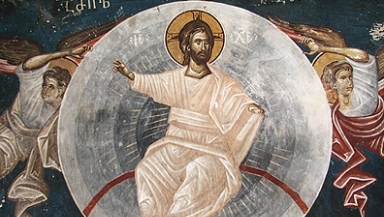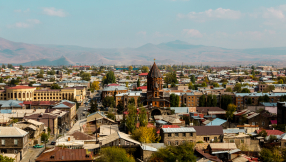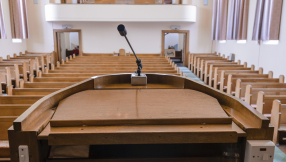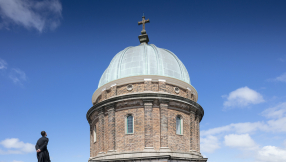
There's a church in Walsingham in Norfolk that has a rather unusual ceiling decoration. It's a pair of feet.
The church is the Chapel of the Ascension and the sculpture is a visual representation of what is, if we're honest, one of the odder New Testament stories. Luke tells it twice, in his Gospel (24:44-53) and in Acts 1:4-11. Jesus is visibly removed from the earth in the presence of his disciples and taken up to heaven.
Opinions might vary as to the precise nature of the disciples' experience. Some find the story uncomfortably literalistic, as though 'heaven' were a couple of miles upwards and the disciples were waving him off, as it were, on a sort of reverse sky-dive. On the other hand, as CS Lewis pointed out in his book Miracles, heaven might well have been imagined as being 'up there' by a first-century fisherman and when Jesus finally did take his leave, the only way they could express this is by the idea of 'ascension'.
But arguments over what a camera might have recorded are a bit of a distraction from what the Ascension means to us today. It would be very sad if nervousness about its perceived difficulty made preachers reluctant to engage with such an important doctrine. So here are three points that might make a sermon.
1. Jesus dwells in our hearts
The famous 'sinners prayer' beloved by evangelists encourages converts to invite Jesus into their hearts. But that's missing the point: Jesus came 'down' – that spatial reference again – to earth and was incarnated as a human being. As he was dying he cried "It is accomplished." But John 14:6 tells us he said, "I will ask the Father, and he will give you another advocate to help you and be with you forever" (NIV). So it's the Spirit who dwells in our hearts, not the Son.
A small point? No: there's a rich and powerful set of ideas around the activity of the Spirit in our lives that we lose if we don't honour the Spirit's work. The Spirit changes us, empowers us and inspires us. Jesus quoted Isaiah in the synagogue at Nazareth when he said, "The Spirit of the Lord is on me, because he has anointed me to proclaim good news to the poor. He has sent me to proclaim freedom for the prisoners and recovery of sight for the blind, to set the oppressed free, to proclaim the year of the Lord's favour" (Luke 14:18-19, NIV); that's our mission too.
Revelation 5 has a stunning picture of Jesus worshipped by all manner of heavenly beings who were singing "Worthy is the Lamb". The Ascension is not just a simple leave-taking, it's a triumphal procession: "The head that once was crowned with thorns/ Is crowned with glory now." When we sing our praises to Jesus, we are worshipping the Ascended Lord, who sends his Spirit to transform our earthly lives.
2. Jesus has gone away
Because of the ascension of Jesus, the barrier between earth and heaven has been pierced. It is what was symbolised in the tearing of the Temple curtain when Jesus died. In the early chapters of Acts, there's a flurry of angelic activity: earth and heaven are nearer than they have ever been. Because Jesus has ascended to the Father and rules with him, God through his Spirit is living and active in the world and in the lives of believers in a new and powerful way.
The poet Francis Thompson reflected on the Old Testament story of Jacob, who saw a ladder from earth to heaven and angels ascending and descending upon it, in his poem The Kingdom of God. He writes of "the traffic upon Jacob's ladder/ Pitched betwixt Heaven and Charing Cross" and "Christ walking on the water/ Not of Gennesareth, but Thames".
We should never imagine that God is remote or inaccessible. The biblical picture is of Jesus still being involved in the world to which he came.
The ascension of Jesus does not mean the absence of Jesus: it means his presence, shown often in weakness and in what's small and despised, but backed by the infinite power and glory of Godhead.
3. Jesus is somehow different
On the face of it, it is a shocking statement to say that there's a man in heaven. But though we shouldn't hesitate to say that God is eternal, all-knowing, all-powerful and all-sufficient, that's what the Bible says: that Jesus took his glorified human nature into the presence of God.
Just as Jesus invites Thomas to explore the physical wounds of his resurrection body, Revelation 5:6 describes John's vision of "a Lamb, looking as if it had been slain" – in other words, sacrificed: or crucified. Resurrection and ascension did not magically erase the wounds Christ suffered on earth: he carried them into heaven, and the Ascended Lord is the Crucified Lord.
There's a rich vein of preaching and teaching to mine in this thought. One of its gems is in Hebrews 4:15-16: "For we do not have a high priest who is unable to feel sympathy for our weaknesses, but we have one who has been tempted in every way, just as we are – yet he did not sin. Let us then approach God's throne of grace with confidence, so that we may receive mercy and find grace to help us in our time of need."
The scars of Jesus represent not just the physical damage inflicted on him, but all the wounds of humanity. The sins, failures and disappointments common to all of us are carried up with him to heaven. Nothing is left unredeemed: Jesus has done everything needed to save everyone forever.
Follow @RevMarkWoods on Twitter.













